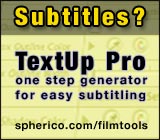|
|
Forum List
>
Café LA
>
Topic
DVCPRO HD (tape) workflow?...
Posted by Danimal
|
DVCPRO HD (tape) workflow?... December 09, 2010 12:48PM |
Registered: 13 years ago Posts: 16 |
Hi. I'm hoping someone here can shed some insight as to whether or not this workflow is legit.
1. Footage was shot at "30p" at 1080 on a HDX-900 to DVCPRO HD tape. If I understand this right the "30p" is really 29.97 over 59.94 - I kind of understand what this means, but not entirely.
2. Tapes were digitized from a AJHD1400 via SDI through a Blackmagic Decklink card into Final Cut Pro 6.0.6 using FCP's Capture Preset, Blackmagic HDTV 1080i 59.94 - DVCPRO HD.
3. FCP Sequence Settings are...
-- General Tab --
Frame Size / 1280x1080 (16:9)
Pixel Aspect Ratio / HD (1280x1080)
Field Dominance / Upper (Odd)
Editing Timebase / 29.97
Compressor / DVCPRO HD 1080i60
Quality / 100%
Audio Settings...
Rate / 48kHz
Depth / 16-bit
Config / Channel Grouped
4. After the edit is locked I go into the Sequence Settings and make a few changes...
Sequence Settings...
-- Video Processing Tab --
Render all YUV material in high-precision YUV
Process Maximum White as / White
Motion Filtering Quality / Best
-- Render Control Tab --
Render & Playback...
Filters / Check
Frame Blending For Speed / Check
5. From here I either...
Print to Tape for a master. (FCP > AJHD1400)
Export a Self Contained Quicktime using Current Settings for a digital master.
Export a Self Contained Quicktime using Apple Pro Res 422 (HQ) 1920x1080p30 for DVD. (Self Contained Quicktime > Compressor's 90 Best DVD Template > DVDSP).
Print to tape in HD, use the deck's downconverter to recapture the video using 8-Bit, 10-Bit, or Pro Res HQ NTSC, run that through Compressor using the 90min Best template, and bring that into DVDSP for, what I've found, the best looking DVD.
Questions...
Firstly,does this look right? Anything you'd be doing differently?
Does changing my Video Processing controls effect the Print to Tape? Does it effect my export to a Self Contained Quicktime? Any details or links to something that can explain the relationship between Video Processing and exporting/laying off in more detail would be great. The manual didn't really go into a lot of detail.
Why is it that when I lay off a project to tape and then capture it using the deck's (AJHD1400) downconversion and run that through compressor using the 90min Best template, it looks better than when I run a Self Contained Quicktime through compressor and into DVDSP? The difference in quality is most noticeable in moves across organic textures. For example, a pan across a field of shrubs looks more "digital", with comparatively harder edges, and artifacts (pixel-shifting) between edges when compared to a DVD that went from FCP to the deck and then back into FCP using the deck's downconversion and the Pro Res NTSC capture preset.
Lastly, I have some rolling credits (bottom to top) that look good when I export a Self Contained Quicktime using Apple Pro Res HQ 1920x1080p30, run that through Compressor using the 90min Best template, and bring that into DVDSP. But, if I layoff to tape, capture back to standard def, and run the gauntlet of Compressor (90min Best) to DVDSP, the images look great, but the credits look worse. Is this a field issue?
Comp/Software/Hardware Specs...
-- Comp --
MacPro
Mac OS X
10.6.4
Processor / 2 x 2.66 GHz Quad-Core Intel Xeon
Memory / 8 GB 1066 MHz DDR3
-- Graphics --
NVIDIA GeForce GT 120
-- FCP --
6.0.6, up to date drivers and what-not
-- Blackmagic Decklink --
7.9.3, up to date
I'm not expecting anyone to really have simple answers to this, or all the answers, but any knowledge as to what looks good, bad, and what you'd change would be appreciated.
Thanks,
Dan
1. Footage was shot at "30p" at 1080 on a HDX-900 to DVCPRO HD tape. If I understand this right the "30p" is really 29.97 over 59.94 - I kind of understand what this means, but not entirely.
2. Tapes were digitized from a AJHD1400 via SDI through a Blackmagic Decklink card into Final Cut Pro 6.0.6 using FCP's Capture Preset, Blackmagic HDTV 1080i 59.94 - DVCPRO HD.
3. FCP Sequence Settings are...
-- General Tab --
Frame Size / 1280x1080 (16:9)
Pixel Aspect Ratio / HD (1280x1080)
Field Dominance / Upper (Odd)
Editing Timebase / 29.97
Compressor / DVCPRO HD 1080i60
Quality / 100%
Audio Settings...
Rate / 48kHz
Depth / 16-bit
Config / Channel Grouped
4. After the edit is locked I go into the Sequence Settings and make a few changes...
Sequence Settings...
-- Video Processing Tab --
Render all YUV material in high-precision YUV
Process Maximum White as / White
Motion Filtering Quality / Best
-- Render Control Tab --
Render & Playback...
Filters / Check
Frame Blending For Speed / Check
5. From here I either...
Print to Tape for a master. (FCP > AJHD1400)
Export a Self Contained Quicktime using Current Settings for a digital master.
Export a Self Contained Quicktime using Apple Pro Res 422 (HQ) 1920x1080p30 for DVD. (Self Contained Quicktime > Compressor's 90 Best DVD Template > DVDSP).
Print to tape in HD, use the deck's downconverter to recapture the video using 8-Bit, 10-Bit, or Pro Res HQ NTSC, run that through Compressor using the 90min Best template, and bring that into DVDSP for, what I've found, the best looking DVD.
Questions...
Firstly,does this look right? Anything you'd be doing differently?
Does changing my Video Processing controls effect the Print to Tape? Does it effect my export to a Self Contained Quicktime? Any details or links to something that can explain the relationship between Video Processing and exporting/laying off in more detail would be great. The manual didn't really go into a lot of detail.
Why is it that when I lay off a project to tape and then capture it using the deck's (AJHD1400) downconversion and run that through compressor using the 90min Best template, it looks better than when I run a Self Contained Quicktime through compressor and into DVDSP? The difference in quality is most noticeable in moves across organic textures. For example, a pan across a field of shrubs looks more "digital", with comparatively harder edges, and artifacts (pixel-shifting) between edges when compared to a DVD that went from FCP to the deck and then back into FCP using the deck's downconversion and the Pro Res NTSC capture preset.
Lastly, I have some rolling credits (bottom to top) that look good when I export a Self Contained Quicktime using Apple Pro Res HQ 1920x1080p30, run that through Compressor using the 90min Best template, and bring that into DVDSP. But, if I layoff to tape, capture back to standard def, and run the gauntlet of Compressor (90min Best) to DVDSP, the images look great, but the credits look worse. Is this a field issue?
Comp/Software/Hardware Specs...
-- Comp --
MacPro
Mac OS X
10.6.4
Processor / 2 x 2.66 GHz Quad-Core Intel Xeon
Memory / 8 GB 1066 MHz DDR3
-- Graphics --
NVIDIA GeForce GT 120
-- FCP --
6.0.6, up to date drivers and what-not
-- Blackmagic Decklink --
7.9.3, up to date
I'm not expecting anyone to really have simple answers to this, or all the answers, but any knowledge as to what looks good, bad, and what you'd change would be appreciated.
Thanks,
Dan
|
Re: DVCPRO HD (tape) workflow?... December 09, 2010 01:45PM |
Moderator Registered: 16 years ago Posts: 8,836 |
>Any details or links to something that can explain the relationship between Video Processing and
>exporting/laying off in more detail would be great.
Video processing is more related to render precision. When you export/layoff, you always lay off from rendered files or from the source file if your footage does not require rendering. Rendering in single precision float (aka. High precision YUV), means your footage is bumped up to 32 bit floating point, rendered across filter stacks before being compressed to your sequence codec. This minimizes rounding errors and banding artifacts that may occur when you render in 8 bits. However, if the effect does not support 32 bit floating point, your image will be truncated to 8 bits. Also, there are some effects (notably FxPlugs) that will yield different results when rendering in 8 bits as compared to rendering in float.
>it looks better than when I run a Self Contained Quicktime through compressor and into DVDSP
It depends on what algorithm is used for the down conversion, and also whether the footage is progressive or interlaced. Progressive is easier to resize, while interlaced is trickier.
>the images look great, but the credits look worse. Is this a field issue?
It is hard to tell without looking at your picture.

www.strypesinpost.com
>exporting/laying off in more detail would be great.
Video processing is more related to render precision. When you export/layoff, you always lay off from rendered files or from the source file if your footage does not require rendering. Rendering in single precision float (aka. High precision YUV), means your footage is bumped up to 32 bit floating point, rendered across filter stacks before being compressed to your sequence codec. This minimizes rounding errors and banding artifacts that may occur when you render in 8 bits. However, if the effect does not support 32 bit floating point, your image will be truncated to 8 bits. Also, there are some effects (notably FxPlugs) that will yield different results when rendering in 8 bits as compared to rendering in float.
>it looks better than when I run a Self Contained Quicktime through compressor and into DVDSP
It depends on what algorithm is used for the down conversion, and also whether the footage is progressive or interlaced. Progressive is easier to resize, while interlaced is trickier.
>the images look great, but the credits look worse. Is this a field issue?
It is hard to tell without looking at your picture.

www.strypesinpost.com
|
Re: DVCPRO HD (tape) workflow?... December 10, 2010 11:37AM |
Registered: 16 years ago Posts: 426 |
Quote
Danimal
Questions...
Firstly,does this look right? Anything you'd be doing differently?
Dan, I would like to thank you for taking the time to clearly state your situation and for mentioning the details of your setup. If more people did this when they post, it would make helping them so much easier (and yield faster responses, no doubt).
Generally speaking, your workflow choices seem pretty good.
Quote
Danimal
Why is it that when I lay off a project to tape and then capture it using the deck's (AJHD1400) downconversion and run that through compressor using the 90min Best template, it looks better than when I run a Self Contained Quicktime through compressor and into DVDSP? The difference in quality is most noticeable in moves across organic textures. For example, a pan across a field of shrubs looks more "digital", with comparatively harder edges, and artifacts (pixel-shifting) between edges when compared to a DVD that went from FCP to the deck and then back into FCP using the deck's downconversion and the Pro Res NTSC capture preset.
When you use the built-in Compressor settings, such as "DVD 90 min Best," your video is being downconverted and MPEG-2 encoded at the same time (for each pass). That's probably not optimal.
You may want to try downconverting your exported self-contained QT as a single operation. Then, take the resulting SD file and do the MPEG-2 encoding (you can use the same "DVD 90 min Best" setting). You may also consider chaining your downconversion and encoding together in Compressor (search for "Job Chaining" in the Compressor docs).
There are some other esoteric things that can also affect the quality of your encoding, such as using QMaster and distributed processing, which I won't go into further.
Quote
Danimal
Lastly, I have some rolling credits (bottom to top) that look good when I export a Self Contained Quicktime using Apple Pro Res HQ 1920x1080p30, run that through Compressor using the 90min Best template, and bring that into DVDSP. But, if I layoff to tape, capture back to standard def, and run the gauntlet of Compressor (90min Best) to DVDSP, the images look great, but the credits look worse. Is this a field issue?
As strypes mentioned, it's hard to tell for sure what's causing this, without having samples of your video from before and after...
I would suggest you consider adding another "phase" to your workflow, when you go from HD to SD. If quality is paramount and time adequate, I would suggest the following general workflow outline:
- Export a self-contained QT file in ProRes 422 (HQ) (or better) as an HD master, without any text or other graphics.
- Downconvert the video to SD using Compressor or your tape deck or other HW/SW tools.
- Import the SD QT file back into FCP, add text, etc., and possibly do some color correction. Render, then export an SD master (w/titles, etc.).
- Convert the SD master using Compressor, using the "DVD 90 min Best" settings. Even better, make some adjustments to the settings for optimal quality (bit rate, etc.). Sometimes, adding compression markers before encoding can improve the quality on portions of your video with lots of motion, etc.
The idea here is that your "fork" your project into HD and SD variants, depending on the final output/delivery format. If you want even better quality for your DVDs, you may consider using another MPEG-2 encoder, such as the one made by Cinema Craft (it functions as a "plugin" in Compressor).
Of course, you should test various approaches and seek expert advice, as needed...
-Dave
|
Re: DVCPRO HD (tape) workflow?... December 11, 2010 06:40AM |
Registered: 17 years ago Posts: 493 |
Quote
Why is it that when I lay off a project to tape and then capture it using the deck's (AJHD1400) downconversion and run that through compressor using the 90min Best template, it looks better than when I run a Self Contained Quicktime through compressor and into DVDSP?
I am just taking a guess here, using something I have observed doing web compressions from HD Digital Masters. I have found that you get better looking final results if you slightly blur the images prior to scaling and compression. Typically I use Episode for this process, and as part of their scaling engine they allow you to add a low pass filter. Basically this throws out the high frequency video information, effectually reducing the resolution of the image prior to compressing it. As a result the compression engine is now using it's bits to compress the parts of the image you see, not wasting them on details that will not show up in the much smaller video you are creating.
I suspect that the hardware down convert in your deck may be doing something similar. As far as I have been able to find, Compressor does not offer a pre-filter to do this. You can try adding just a hint (0.5?) of gaussian blur to your video prior to compressing and see if that helps. As others have mentioned, if you do your scaling as a separate pass you also help your cause. Another thing to try is do the scaling pass as a high data rate h.264, and use that to feed Compressor. It is counter-intuitive to add an additional stage of compression, but oddly it does act as a low pass filter.
Mind that these techniques are one I use when squeezing down for web delivery. I have not tried them for MPEG-2 for DVD. Your mileage may very.
-V
|
Re: DVCPRO HD (tape) workflow?... December 11, 2010 11:04AM |
Registered: 16 years ago Posts: 426 |
Quote
VPiccin
I am just taking a guess here, using something I have observed doing web compressions from HD Digital Masters. I have found that you get better looking final results if you slightly blur the images prior to scaling and compression. Typically I use Episode for this process, and as part of their scaling engine they allow you to add a low pass filter. Basically this throws out the high frequency video information, effectually reducing the resolution of the image prior to compressing it. As a result the compression engine is now using it's bits to compress the parts of the image you see, not wasting them on details that will not show up in the much smaller video you are creating.
Vance, that's a good guess, and actually a valid insight. Thanks for mentioning that.

De-noising video, or softening it a bit as you mentioned (and something which may be a by-product of the downconversion in the tape deck by Dan), is a good thing to do just before encoding video to MPEG-2. Because of the way the encoding algorithms work, this "pre-adjustment" can significantly improve the look of the resulting MPEG-2 file (by making the encoder more efficient, etc.).
Although my workflow outline was quite rough, I probably should have mentioned this step. I'd probably add it as step "3b" or something like that...
There are several pretty good de-noising filters available for use with FCP/FCS. Here is a sample (in no particular order): Neat Video, DE:Noise, Video Purifier (also does scaling), Nattress Film Effects and Big Box of Tricks (in several of the bundled tools), and Magic Bullet Denoiser.
Judicious use of these kinds of tools can help make your video look less "harsh" and improve the efficiency of MPEG-2 encoding...
-Dave
|
Re: DVCPRO HD (tape) workflow?... December 15, 2010 10:18AM |
Registered: 13 years ago Posts: 16 |
Sorry, only registered users may post in this forum.



 All the news now and in your digital future
All the news now and in your digital future